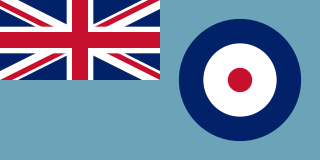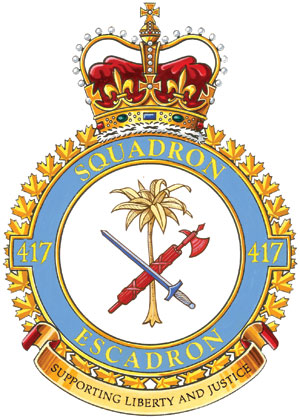
The Desert Air Force (DAF), also known chronologically as Air Headquarters Western Desert, Air Headquarters Libya, the Western Desert Air Force, and the First Tactical Air Force (1TAF), was an Allied tactical air force created from No. 204 Group RAF under RAF Middle East Command in North Africa in 1941 to provide close air support to the British Eighth Army against Axis forces. Throughout the Second World War, the DAF was made up of squadrons from the Royal Air Force (RAF), the South African Air Force (SAAF), the Royal Australian Air Force (RAAF), the United States Army Air Forces (USAAF) and other Allied air forces.

417 Combat Support Squadron is an Air Force unit with the Canadian Forces. Based at CFB Cold Lake it provides helicopter support to the base operations. Since 1994, it has also provided search and rescue.

The 396th Bombardment Group is a former United States Army Air Forces unit. It was active during World War II as a Boeing B-17 Flying Fortress Operational Training Unit, training newly organized units, then as a Replacement Training Unit for aircrews. It was inactivated in 1944 in a general reorganization of Army Air Forces training units..

Northwest African Air Forces (NAAF) was a component of the Allied Mediterranean Air Command (MAC) during February–December 1943. It was responsible primarily for air operations during the Tunisian Campaign and bombing of Italy. Its commander was Lieutenant General Carl Spaatz of the United States Army Air Force. NAAF was created following a reorganization of the command structure of Allied air forces in the Mediterranean Theatre. The other components of MAC were Middle East Command (MEC), AHQ Malta, RAF Gibraltar and 216 Group.

The Mediterranean Allied Air Forces (MAAF) was the major Allied air force command organization in the Mediterranean theater from mid-December 1943 until the end of the Second World War.
The Mediterranean Air Command (MAC) was a World War II Allied air-force command that was active in the North African and Mediterranean Theater of Operations (MTO) between February 18 and December 10, 1943. MAC was under the command of Air Chief Marshal Sir Arthur Tedder, whose headquarters were next to those of the Supreme Allied Commander, General Dwight D. Eisenhower, in Algiers, Algeria, during the planning of the Allied campaigns in Tunisia, Pantelleria, Sicily, and the invasion of mainland Italy during the war.
The Northwest African Coastal Air Force (NACAF) was a specialized functional command of the combined Northwest African Air Forces. The Mediterranean Air Command (MAC) oversaw the combined air forces until superseded by the MAAF.
The Northwest African Strategic Air Force (NASAF) was a sub-command of the Northwest African Air Forces (NAAF) which itself was a sub-command of the Mediterranean Air Command (MAC). These new Allied air force organizations were created at the Casablanca Conference in January 1943 to promote cooperation between the British Royal Air Force (RAF), the American United States Army Air Forces (USAAF), and their respective ground and naval forces in the North African and Mediterranean Theater of Operations (MTO).
The Northwest African Tactical Air Force (NATAF) was a component of the Northwest African Air Forces which itself reported to the Mediterranean Air Command (MAC). These new Allied air force organizations were created at the Casablanca Conference in January 1943 to promote cooperation between the British Royal Air Force (RAF), the American United States Army Air Force (USAAF), and their respective ground and naval forces in the North African and Mediterranean theater of World War II. Created on February 18, 1943, the NATAF and other MAC commands existed until December 10, 1943, when MAC was disbanded and the Mediterranean Allied Air Forces (MAAF) were established.

The Northwest African Troop Carrier Command (NATCC) was a combined British-U.S. air command of the Second World War.
The Northwest African Air Service Command (NAASC) was a sub-command of the Northwest African Air Forces which itself was a sub-command of the Mediterranean Air Command (MAC). These new Allied air force organizations were created at the Casablanca Conference in January 1943 to promote cooperation between the British Royal Air Force (RAF), the American United States Army Air Force (USAAF), and their respective ground and naval forces in the North African and Mediterranean Theater of Operations (MTO). Effective March 4, 1943, Brigadier General Delmar Dunton became the commander of NAASC which consisted of service units from the United States Army 12th Air Force Service Command which Dunton had overseen since September 30, 1942, and similar units from the British RAF Middle East Command. In June 1943, prior to the invasion of Sicily, Brigadier General Harold Bartron became the commander of NAASC. On December 10, 1943, MAC was disbanded and NAASC was reorganized in the newly established Mediterranean Allied Air Forces.
The Northwest African Training Command (NATC) was a sub-command of the Northwest African Air Forces (NAAF) which itself was a sub-command of the Mediterranean Air Command (MAC). These new Allied air force organizations were created at the Casablanca Conference in January 1943 to promote cooperation between the British Royal Air Force (RAF), the American United States Army Air Force (USAAF), and their respective ground and naval forces in the North African and Mediterranean Theater of Operations (MTO). Effective February 18, 1943, the NATC and other MAC commands existed until December 10, 1943 when MAC was disbanded and the Mediterranean Allied Air Forces (MAAF) were established.

No. 201 Group was a group of the Royal Air Force during the Second World War.

No. 205 Group was a long-range, heavy bomber group of the Royal Air Force (RAF) established on 23 October 1941 by boosting No. 257 Wing to Group status.

Air Headquarters Malta was an overseas command of the Royal Air Force (RAF) during the Second World War. It was established on 28 December 1941 by renaming RAF Mediterranean under Air Vice Marshal Hugh Lloyd. Lloyd was named Air Officer Commanding in Malta on 1 June 1941.

No. 211 Group RAF is a former Royal Air Force group which disbanded in September 1943. It initially formed in December 1941, then disbanded in February 1942. The group immediately reformed in March 1942 as No. 211 Group within RAF Middle East Command.
Air Headquarters Air Defences Eastern Mediterranean was a sub-command of RAF Middle East Command which itself was a sub-command of the Mediterranean Air Command during World War II. Air H.Q. Air Defences Eastern Mediterranean was established on 4 March 1943, by renaming the RAF command known as AHQ Egypt. Air Vice Marshal Richard Saul was the only commander of Air HQ Air Defences Eastern Mediterranean which was renamed Air HQ Eastern Mediterranean on 1 February 1944.

No. 242 Group was a group of the British Royal Air Force (RAF) formed on 24 August 1942. Its first commander was Air Commodore George Lawson.

Middle East Command was a command of the Royal Air Force (RAF) that was active during the Second World War. It had been preceded by RAF Middle East, which was established in 1918 by the redesignation of HQ Royal Flying Corps Middle East that had been activated in 1917 although a small Royal Flying Corps presence had been operational in the region since 1914.

The South Atlantic Wing, Air Transport Command is a former United States Army Air Forces unit. It was organized in 1942 to ferry aircraft and transport personnel and equipment from the Caribbean to the Mediterranean Theater of Operations, European Theater of Operations, China-Burma-India Theater and for delivery of lend lease aircraft to the Soviet Union. It also transported critical material from South America. The wing commander also served as the United States Army theater commander for South America. After V-E Day, the wing became responsible for the return of aircraft and personnel to the United States. It was inactivated in 1946 as operations in the South Atlantic decreased.










